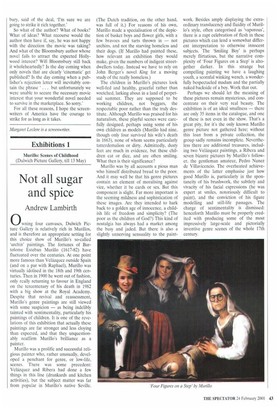Murillo: Scenes of Childhood (Dulwich Picture Gallery, till 13 May)
Not all sugar and spice
Andrew Lambirth
Owning four canvases, Dulwich Picture Gallery is relatively rich in Murillos, and is therefore an appropriate setting for this choice show of Murillo's so-called 'urchin' paintings. The fortunes of Bartolome Esteban Murillo (1617-82) have fluctuated over the centuries. At one point more famous than Velazquez outside Spain (and on a par with Raphael), Murillo was virtually idolised in the 18th and 19th centuries. Then in 1900 he went out of fashion, only really returning to favour in England on the tercentenary of his death in 1982 with a big show at the Royal Academy. Despite that revival and reassessment, Murillo's genre paintings are still viewed with some suspicion — as being indelibly tainted with sentimentality, particularly his paintings of children. It is one of the revelations of this exhibition that actually these paintings are far stronger and less cloying than expected, and that they unquestionably reaffirm Murillo's brilliance as a painter.
Murillo was a prolific and successful religious painter who, rather unusually, developed a penchant for genre, or low-life, scenes. There was some precedent: Velazquez and Ribera had done a few things in this line (drunkards and kitchen activities), but the subject matter was far from popular in Murillo's native Seville. (The Dutch tradition, on the other hand, was full of it.) For reasons of his own, Murillo made a specialisation of the depiction of basket boys and flower girls, with a few bravoes and tarts thrown in — not urchins, and not the starving homeless and their dogs. (If Murillo had painted these, how relevant an exhibition they would make, given the numbers of indigent streetdwellers today. Instead we have to rely on John Berger's novel King for a moving study of the really homeless.) The children in Murillo's pictures look well-fed and healthy, graceful rather than wretched, larking about in a land of perpetual summer. They are supposed to be working children, not beggars, the respectable poor rather than the truly destitute. Although Murillo was praised for his naturalism, these playful scenes were carefully designed, perhaps using some of his own children as models (Murillo had nine, though only four survived his wife's death in 1663), none of whom seems particularly tatterdemalion or dirty. Admittedly, dusty feet are much in evidence, but these children eat or dice, and are often smiling. What then is their significance?
Murillo was by all accounts a pious man who himself distributed bread to the poor. And it may well be that his genre pictures contain an element of moralising against vice, whether it be cards or sex. But this component is slight. Far more important is the seeming mildness and sophistication of these images. Are they intended to hark back to a golden age of innocence, a childish life of freedom and simplicity? (The poor as the children of God?) This kind of nostalgia has always had a market among the busy and jaded. But there is also a slightly unnerving sensuality to the paint
work. Besides amply displaying the extraordinary translucency and fluidity of Murillo's style, often categorised as 'vaporous', there is a rapt celebration of flesh in these pictures which can lend a somewhat different interpretation to otherwise innocent subjects. The 'Smiling Boy' is perhaps merely flirtatious, but the narrative complexity of 'Four Figures on a Step' is altogether darker. In this strange but compelling painting we have a laughing youth, a scornful winking wench, a wonderfully bespectacled madam and the partially naked backside of a boy. Work that out.
Perhaps we should let the meaning of these pictures remain mysterious, and concentrate on their very real beauty. The exhibition is of an ideal smallness — there are only 35 items in the catalogue, and one of these is not even in the show. That's a great pity, for it's the only known Murillo genre picture not gathered here; without this loan from a private collection, the group sadly remains incomplete. Nevertheless there are additional treasures, including two Velazquez paintings, a Ribera and seven bizarre pictures by Murillo's follower, the gentleman amateur, Pedro Nunez de Villaviceneio. The overheated achievements of the latter emphasise just how good Murillo is, particularly in the spontaneity of his brushwork, the subtlety and vivacity of his facial expressions (he was expert at smiles, notoriously difficult to paint), and the conviction of his figure modelling and still-life passages. The charge of sentimentality is dismissed: henceforth Murillo must be properly credited with producing some of the most impressively large-scale and pictorially inventive genre scenes of the whole 17th century.


































































 Previous page
Previous page